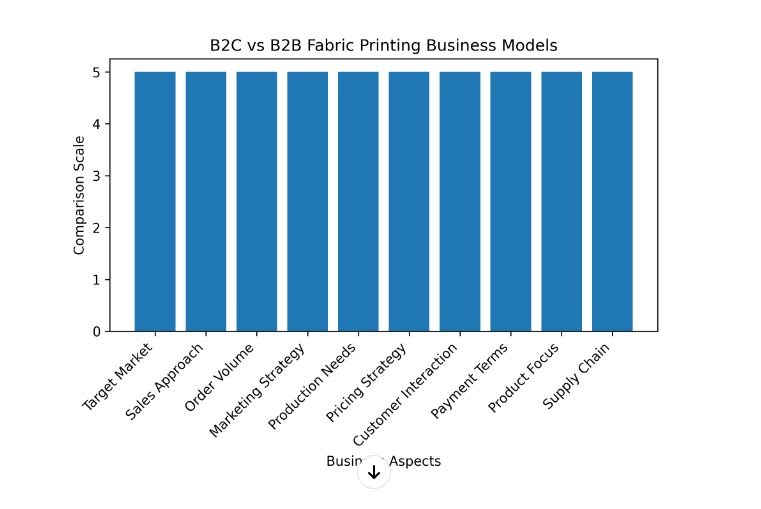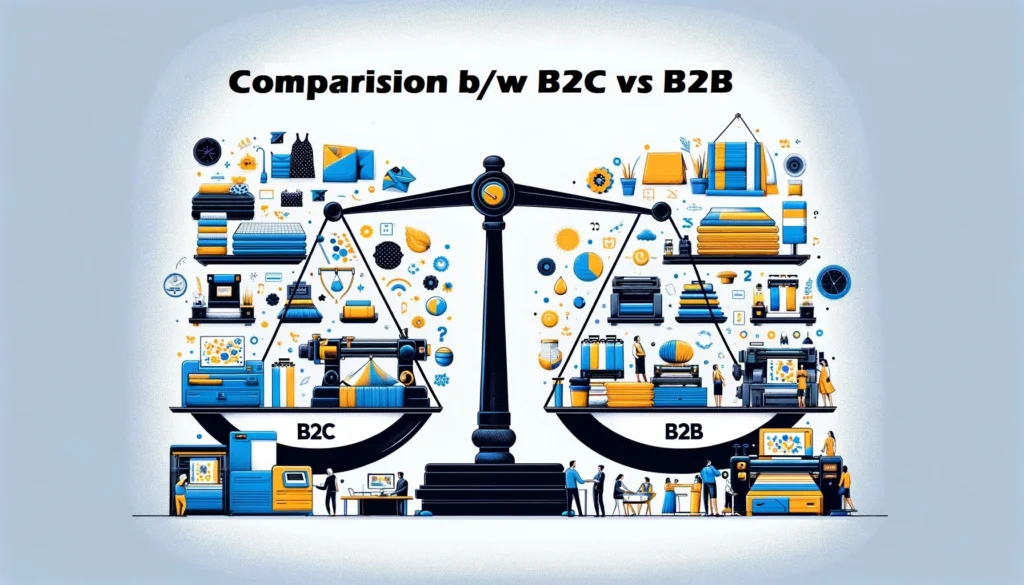According to the Global Industry Analysts Inc. report, the global digital textile printing market is projected to reach $4.4 billion by 2026. This incredible growth opens lucrative opportunities for entrepreneurs aspiring to start a profitable fabric printing business.
With the proliferation of on-demand apparel production and mass personalization, starting a fabric printing venture can be highly rewarding. Custom-printed designs allow people to showcase unique styles and aesthetics. Considering the potential, this article provides a detailed walkthrough on how to start a fabric printing business can be both exhilarating and challenging.
We will explore essential aspects like evaluating market viability, selecting optimal printing techniques, building production capabilities and sales channels, and defining brand identity. By understanding industry dynamics and following expert strategies, you can establish a distinguished and thriving fabric printing business.
Specifically, we will cover:
- Assessing growth potential by analyzing printed textile industry trends
- Developing a customer-centric production and sales model
- Making strategic decisions regarding printing methods, equipment sourcing, operational workflows
- Building brand awareness by targeting appropriate customer segments
- Understanding legal, financial, and marketing considerations
With adequate planning and commitment, a home-based fabric printing startup can rapidly blossom into a million-dollar digital textile enterprise. Let’s get started!
Tips, Trends, and Insights to Start a Fabric Printing Business

Market Analysis for the Fabric Printing Business
The global printed textile and apparel industry was valued at around $420 billion as of 2022. Market reports project the industry to expand at a CAGR of 4.5% from 2023 to 2028 led by emerging economies.
Some Notable Trends Driving this Growth are:
- Trend 1: On-Demand Production Models – The demand for personalized and customized apparel has given rise to on-demand production services and print-on-demand solutions. Online platforms like Printify, Printful, and Teespring allow consumers to design unique t-shirts which are then printed and shipped directly.
- Trend 2: Digital Textile Design Software – Advancements in digital textile printing technology along with 3D simulation software provide expanded design capabilities. Adobe Textile Designer plugins are widely adopted for pattern and textile visualization.
SWOT Analysis of Fabric Printing Businesses:
Strengths:
- Catering to niche customization needs
- Technological advancements, diverse printing techniques, and a shift toward sustainable fabric printing
- Lower overhead than traditional manufacturing
- Online retail minimizes distribution costs
Weaknesses:
- Limited design portfolio
- High initial investment and the need for specialized knowledge
- Dependent on third-party suppliers
- New ventures lack brand recognition
Opportunities:
- Integration with e-commerce platforms
- Growing apparel market and demand for personalized products
- Expansion into B2B services
- New technology like digital printing
Threats:
- Competition from large textile conglomerates
- Market saturation and rapid technological changes
- High attrition among solo entrepreneurs
- Changing compliance norms
Your Fabric Printing Business Model
When starting a fabric printing business, you need to make strategic decisions regarding your operating model:
B2C vs B2B
Deciding on a business model is crucial. Will your venture cater to businesses (B2B) or directly to consumers (B2C)? Each model has its unique dynamics and requires a different approach to marketing and sales.

A B2C model sells customized apparel directly to end consumers via online channels. B2B caters to corporate clients for uniforms and merchandising needs. Based on resource capabilities, new ventures can adopt either a hybrid approach.
A Quick Comparision b/w B2C vs B2B

| Parameter | B2C Model | B2B Model |
|---|---|---|
| Target Customer | Individual retail consumers looking for customized apparel and textile products | Focused on consumer goods like t-shirts, bags, home textiles, accessories, etc. Requires developing a retail product portfolio |
| Customer Reach | Companies requiring bulk orders of printed fabrics, apparel, uniforms, etc. | Limited to domestic or overseas corporates depending on production bandwidth |
| Order Volumes | Focused on consumer goods like t-shirts, bags, home textiles, accessories, etc. Requires developing a retail product portfolio | Bulk orders resulting in higher profit margins |
| Product Mix | Focused on consumer goods like t-shirts, bags, home textiles, accessories etc. Requires developing a retail product portfolio | Depends on client needs but usually high-volume batches of similar items |
| Design Input | Design process dictated by individual buyer preferences | Needs alignment with corporate branding and uniform design requirements |
| Sales and Promotions | Retail marketing across digital channels | Lower volumes per order but the possibility of mass personalization |
| Production Planning | B2B marketing focused on tradeshows, corporate gifting catalogs, etc. | Uniform products in bulk implying consistent production schedules |
| Payments and Pricing | Standard online payment options and retail pricing models | Billing cycles and wholesale pricing |
| Supply Chain | May involve a diverse range of suppliers for different materials and designs. | More streamlined, with a focus on reliable and consistent supply for large orders. |
| Overall Viability | Lower entry barriers due to online retail but intensive marketing required | Limited client base but potentially lucrative with large bulk orders |
Printing Techniques
Common techniques include:
- Direct-to-Garment (DTG)
- Dye-Sublimation
- Screen Printing
- 3D printing etc.
Select method(s) based on production volumes, cost implications, and quality requirements. DTG allows printing on dark, and light fabrics with no minimums.
Manufacturing Considerations
- In-House Production: Offers control over quality but requires significant investment in equipment and supplies.
- Outsourcing: Reduces upfront costs but can compromise on customization and turnaround times.
While outsourcing printing and fulfillment is easier initially, developing in-house capabilities provides greater quality control and profits. Many ventures start via Print-on-Demand until investing in equipment and hiring experts.
Operational Considerations
To build your fabric printing production capabilities, you need to invest in specialized equipment and streamline workflows:
- Equipment: Core equipment like direct-to-garment or dye-sublimation printers, heat presses, screen printing equipment, vinyl cutters, etc. Validate technical specifications and production capacity prior to purchasing.
- Textile Raw Materials: Source high-quality fabrics like cotton, polyester, rayon, linen, etc., and other printable media from certified suppliers. Ensure optimal textures for printing techniques.
- Design Software and Graphic Skills: Use software like Adobe Photoshop, Illustrator, CorelDraw, etc. for design conceptualization, editing images, and creating prints. Having in-house graphic design expertise is preferable.
- Production and Inventory: Define operating procedures from order receipt to finished goods. Track inventory of raw materials and monitor work-in-progress. Use just-in-time methods to minimize working capital locked in storage.
- Packaging and Shipping: Procure customized packaging representing brand visual identity. Integrate parcel delivery systems for dispatching finished products. Timely shipments ensure customer satisfaction.
Legal and Financial Framework
Some initial legal and financial aspects include:
- Business Entity Structure: Choose an appropriate structure like sole proprietorship, partnership, LLC, or corporation based on business needs.
- Licenses and Permits: Securing business licenses and operational permits for activities like custom printing is mandatory. Register brand names and logos to protect IP assets.
- Financing: Estimate capital requirements and explore funding options like loans, angel investments, etc. Maintain proper bookkeeping for managing cash flows.
Financial Management
- Financing Options: Exploring avenues for initial funding.
- Business Bank Account: Setting up dedicated financial management.
- Accounting and Taxation: Implement accounting best practices for financial recording, reporting,, and ensuring tax compliance. Consult professionals to understand regulatory needs.
Building Your Fabric Printing Brand
Strategies for branding include:
Brand Identity:
- Brand Assets: Developing a strong visual and thematic identity. Create brand logos, fonts, color schemes, etc. that reflect positioning. Optimal use in marketing collateral.
- Brand Recognition: Establishing your brand in the market.
Marketing Strategies:
- Social Media Marketing: Leveraging platforms for brand exposure.
- Content Marketing: Engaging audiences with valuable content. Leverage social media marketing, emailers, digital ads, and SEO to reach target consumer segments. Highlight customization capabilities.
- Search Engine Marketing (SEM): Enhancing online visibility.
Online Presence and Customer Engagement
- E-commerce Site: Creating a user-friendly online store. Have a user-friendly e-commerce site for customers to view catalogs, upload designs, and place orders. Maintain consistent branding.
- Customer Satisfaction: Focusing on quality service for repeat business. Provide design support, production updates, and easy returns/exchanges. Gather feedback using CSAT surveys. Address issues promptly.
- Customer Retention: Building loyalty through excellent experiences.
By integrating these operational, legal, financial, and branding elements, your fabric printing business can thrive in the competitive market. Remember, success lies in the details – from the equipment you choose to the brand image you cultivate.
Growth Strategies and Opportunities
As a fabric printing entrepreneur, focusing singularly on establishing operations is inadequate. You need a long-term vision to build a formidable brand.

Potential growth levers include:
- Expanding Service Portfolio: Cater to embellishment and fabric manipulation techniques like quilting, embroidery, fabric painting, etc. Offer mixed media offerings.
- Haute Couture and Bespoke: Designs Collaborate with indie designers and fashion houses to translate exclusive prints and patterns onto fabrics. Limited collections enhance brand positioning.
- B2B Production: Provide fabric yardage and sampling services to garment manufacturers, fashion labels, costume designers, etc. Gain steady cash flows.
- Production Optimization: Adopt digital automation and modern textile technologies to maximize output, efficiency, and quality. Enhance capabilities continuously.
- Risk Management: Mitigate foreseeable risks with insurance safeguards, secure debt-free funding, and maintain compliance visibility. Build operational resilience.
With a strategic approach and calculated investments, fabric printing startups can scale into a multifaceted textile business targeting global audiences. The possibilities for entering creative AND lucrative spaces are endless.
Final Thoughts
As we reach the end of this comprehensive guide, I hope the key insights shared have provided clarity and conviction to embark on your entrepreneurial aspirations in the textile printing industry.
The strategic levers explored, from evaluating growth potential to building operational bandwidth to defining branding techniques, equip you with a streamlined approach to establishing a successful fabric printing business.

The responsibility now rests upon you to transform your creative expression into a lucrative enterprise. The transition from concept to realization by dedicating time to:
- Thoroughly research the local and global addressable market
- Speak to industry peers for guidance on critical aspects
- Refine and finalize an executable printing business plan
- Develop skills needed or hire experts to complement strengths
- Diligently work out finance, supply partnerships, and licensing needs
I sincerely hope this guide stimulates ideas that help concretize your next steps. Remember – every towering printing empire started small. With self-confidence, perseverance, and passion, your chance to make an indelible mark catering to customized textile needs is right at your fingertips!
All the best!
Muhammad Asif Saeed has extensive experience in commerce and finance. Specifically, He holds a Bachelor of Commerce degree specializing in Accounts and Finance and an MBA focusing on Marketing. These qualifications underpin his understanding of business dynamics and financial strategies.
With an impressive 20-year career in Pakistan’s textile sector, including roles at Masood Textile (MTM) and Sadaqat Limited, excelling in business & financial management. His expertise in financial and business management is further evidenced by his authoritative articles on complex finance and business operation topics for various renowned websites including businessproplanner.com,businesprotips.com,distinctionbetween.com, trueqube.com, and bruitly.com, demonstrating his comprehensive knowledge and professional expertise in the field.


4 thoughts on “How to Start a Fabric Printing Business: A Complete Guide for 2023”